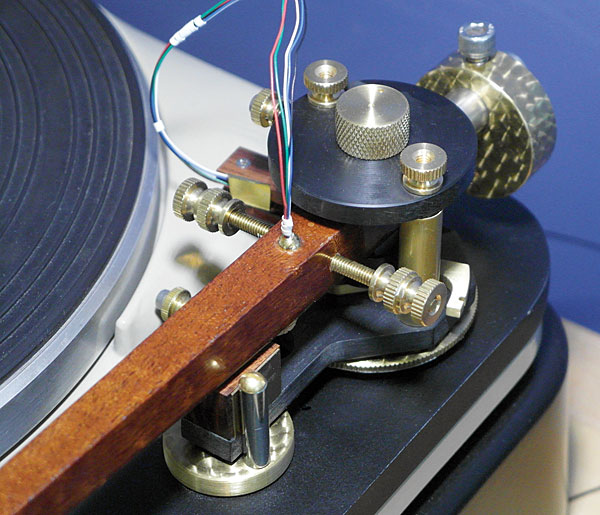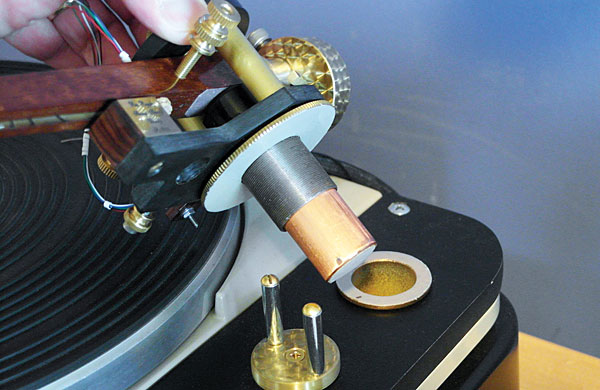| Columns Retired Columns & Blogs |
“Everything should be as simple as possible, but not simpler.”
Designers and critics alike are at their best when they have a point of view—and yet, in the interest of fairness and objectivity, the latter are often required to keep such things to themselves. And that's how it ought to be. I've been hanging the boxers and briefs of my biases long enough on the clothesline of public scrutiny that it has become rare for makers of, say, six-figure, low-efficiency loudspeakers to seek my opinion. But when they do—or when anyone sends me anything for review, really—it is usually my job to limit my comments to a description of the product at hand, explaining, as best as I can, the designer's intentions in doing things that way, and observing how well it did or did not perform in my home.

Not today. This time out I must deviate from my usual practice, if only because Pete Riggle's tonearm departs so drastically from the tonearm norm—from virtually all norms, really—that I cannot, in good conscience, fail to comment.
Most remarkable of all is the manner in which the Woody is fastened to the associated turntable: It isn't. Its threaded-pipe pillar sits loosely in a short bronze fitting that itself fits loosely in the armboard hole. (As Riggle himself made an armboard for my loaner Thorens TD 124 turntable, I assume that my review installation was within the designer's specifications.) To put it bluntly, the entire arm is free to wiggle and wobble and rattle, and the arm's pivot point to move, however slightly.
The design of the Woody's damping system is such that the moving part (the short channel affixed to the underside of the armwand) and the stationary parts (the damping-fluid cup and the upright rod within it) can, during use, come in contact with one another. On p.16 of his instruction manual, Riggle states that it is "unnecessary in practice to adjust the lateral balance of the arm so that the snubber pin is not in continuous contact with the Teflon lined channel." That would not only seem to disqualify the Woody as a unipivot—and contribute to rendering its precise center of rotation a moving target—but would make this the only viscous-damping system of which I'm aware in which the damping fluid is allowed to be short-circuited, if you will, by direct contact between rigid structures.
And some elements of the Woody's design, it must be said, are workarounds. Kludges. The cartridge shims. The guidepost assembly that keeps the arm-mount structure from rotating during use. The stack of cork pads on the underside of the armwand, to help the cueing mechanism do its job. That which seems exhaustively complete and comprehensive to some eyes can appear inelegant and overwrought to others; candor requires me to throw in my lot with the latter.
Still, as I and my best reviewing colleagues are always at pains to point out, the proof is in the listening and nothing else. So listen I did—beginning with my Denon DL-103 cartridge, with the intention of moving on to my Miyajima Mono and Miyabi 47. (Before sending me the Woody, Riggle had asked me to name the pickups I'd be using, so that he could provide all the necessary alternate parts and setup advice.)

Although the Woody is designed to deliver optimal performance when its damping cup is charged with silicone fluid, Riggle suggests that it can also be used without. As a preliminary step, I tried running it dry, but didn't care for the sound, which struck me as rather brash and bereft of bass. In went the goo, injected with an Exel 3ml syringe (included).
Although the Woody would never exhibit terribly good bass extension, the brashness certainly went away, leaving a timbrally colorful, well-textured sound with notably excellent image depth. On the recording by Heather Harper, Neville Marriner, and the Northern Sinfonia of Benjamin Britten's anachronistic Les Illuminations (Angel S-36788), the violins that open the piece sounded nicely, realistically layered from front to back. The pizzicato cellos and bass viols that accompany soprano Harper's entrance didn't have nearly the force that I hear from this record when using the Denon cartridge (with Yamamoto headshell) on my EMT tonearm, but the performance wasn't egregiously lacking in that regard. Happily, the eight original and mostly upbeat numbers on Ornette Coleman's early album Something Else!!! (Contemporary S7551, footnote 4) fared even better, with really good pacing and swing, and fairly good impact—but, again, not much bass depth.
It was time to move on to the next cartridge. In my view, the Miyajima Mono is one of the most exciting phono cartridges released in over a decade: It's exciting to listen to—impactful, colorful, and utterly alive—and it's exciting to think that something this good and this (comparatively) affordable is available in 2013. But the cartridge screws provided with the Woody weren't quite long enough to accommodate the Miyajima. And when I tried other screws from my own parts collection, I discovered that the ones supplied by Riggle are a size smaller than the industry standard, and that the screw-head recesses machined into the Woody's headshell plate are too small for anything else.
In looking to see if the Woody had come with alternate cartridge screws, I discovered, among the many packets of accessories, one that contained a single small, thick, alloy washer. This, like most of the Woody's other spare parts, was packed with its own instruction sheet—one suggesting that, if the owner selects cartridge screws whose heads are too big to fit flush within the recesses provided them, the thick washer must be added to the bolt that holds the headshell to the Headshell Adjuster Plate, to provide necessary clearance: another kludge.
That's when I bailed.
Even hobbled by a mounting arrangement in which the arm as a whole—not just the armwand—was free to travel distances of exponentially greater size than even the coarsest groove modulation, the Pete Riggle Audio Woody played music reasonably well. Groundlessly or not, I can't help but assume that it would sound even better, perhaps considerably so, if it were held in place more solidly.
In use, I found that the Woody's lateral balance-weight arrangement, outsize though it is, had no effect on the armwand after azimuth had been set with Riggle's AZOF mechanism, possibly due to the direct mechanical interference between moving parts once the damping cup had been tilted. If it were up to me, I'd dispense with the AZOF. Shorn of both that and the VTAF (not to mention the clunky guidepost assembly made necessary by the latter's loose fit), and graced with a less flawed damping system, this could, I think, be a much better product. As a bonus, the Woody might also be an even more affordable product—something else to sweeten sour moods.

“Everything should be as simple as possible, but not simpler.”